Day 21: Working Animals Part II—Large Animals (Horses, Donkeys, Mules, Oxen)
Dear Student,
Today, onto the larger non-human helpers you might like to employ on your homestead…
Horses: The Real Horse Power
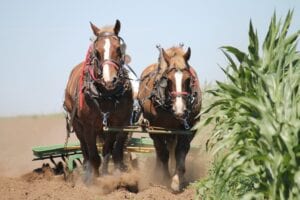 Horses are probably the most commonly used large working animals on the farm in Western culture today.
Horses are probably the most commonly used large working animals on the farm in Western culture today.
They are put to regular use for personal transportation, for hauling, for inspecting and moving herds of animals, and for navigating terrain too steep for machinery and vehicles.
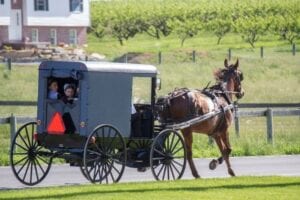 There are still individuals and communities that use horses for a lot more than just individual transport. The traditional Amish and Mennonite communities across the Americas are a good example—their appreciation for and dependence on the noble horse has been integral to their communities for generations, and hasn’t decreased in modern times.
There are still individuals and communities that use horses for a lot more than just individual transport. The traditional Amish and Mennonite communities across the Americas are a good example—their appreciation for and dependence on the noble horse has been integral to their communities for generations, and hasn’t decreased in modern times.
Aside from being highly useful animals, they are good companions. Horses are now used as emotional support animals for people with autism and other developmental problems.
These days, there is a resurgence of interest in horse power on the farm, but, as with anything, there are plenty of pros and cons to using horses…
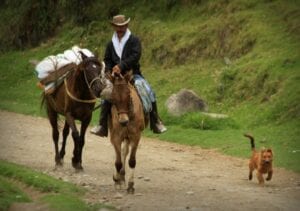 Pros To Using Horses On The Farm:
Pros To Using Horses On The Farm:
- A great big, significant step towards self-sufficiency.
- Reduces your CO2 emissions and carbon footprint.
- They require no fossil fuels to run, and you can grow your own fuel for them (i.e., food) on your own farm.
- They can traverse terrain that machines cannot.
- They damage and compact soil less than tractors.
- Useful in tree-harvesting to pull logs out of forests (that a tractor couldn’t reach).
- Cheaper to buy than tractors.
- Cheaper to run than tractors (if well cared for).
- Tractors can break down or need replacement parts… horses generally don’t (again, assuming they are well cared for).
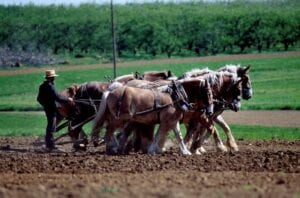 When it comes to landscaping, working with horses allows you to see what you are working on more accurately, allowing for a better-quality finish.
When it comes to landscaping, working with horses allows you to see what you are working on more accurately, allowing for a better-quality finish.- Horses can be used to power machinery, too. Livestock treadmills are used for machine power and electricity generation.
- Draft horses produce 10 to 15 tons of manure each year—a huge benefit to the farm (by comparison, the only thing tractors produce are fumes and oil leaks, releasing toxins into your air and ground).
- If the horse is not working for some time of the year, it may be let out to pasture where it can fend for itself for weeks with little supervision.
- Horses can show intelligence and have great personalities, making them fun to have around and pleasant to work with.
Drawbacks To Using Horses Instead Of Tractors:
- Working horses eat 2% to 3% of their body weight per day. This can be easily covered on pasture when the horse is not
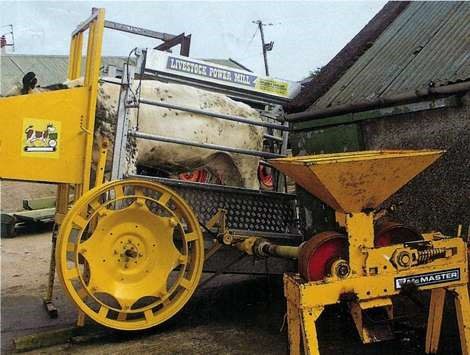
Figure 1 – Livestock power mill allows cows to turn machinery or generate electricity, created by William Taylor working, but when working hard it will need a hay and grain supplement to supply enough calories to keep it strong. (You can grow your own grain to support this if you have the space.)
- Working with a horse is physically harder than driving a tractor.
- Horses are slower than tractors in any but small-scale operations.
- Draft horses can only plough about 2 acres per day, so large-scale grain farming by this method is impractical.
- Horses you work with every day must be cared for every day: fed, watered, groomed, etc.
- Horse power is only efficient close to or on your farm. You can’t take a job 30 miles away using your horses, as the travel time will be too burdensome to make economic sense.
- Horses can get spooked and bolt away… tractors generally don’t.
- Horses can be stubborn and sometimes have disagreeable personalities.
Donkeys
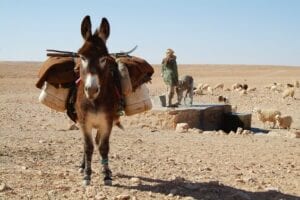 These faithful animals have been used for traction and guard animals for over 5,000 years.
These faithful animals have been used for traction and guard animals for over 5,000 years.
Smaller than horses and stronger for their size, donkeys can handle steeper terrain and are more surefooted then horses.
A well cared for donkey can live for 30 to 50 years.
The big downside to donkeys is their famous obstinance. As you likely already know, donkeys are particularly stubborn animals, attributed to a stronger sense of self preservation and a higher pain tolerance than horses. Donkeys won’t be frightened or bullied into doing something they don’t want to do.
Because of their self-preservation instinct, though, donkeys protect themselves when threatened and are used in developing countries to guard sheep and goat herds.
Donkey milk is a premium product, and there were reports of it selling for US$60 per gallon in Italy a few years back.
Mules (And Hinnies)
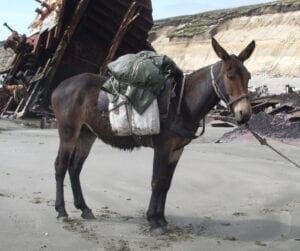 Donkey and horses are members of the same family so can interbreed. Mules are the offspring of a male donkey and a female horse (the other way around begets a hinny). A mule’s size is dictated by the size of its mother (horse).
Donkey and horses are members of the same family so can interbreed. Mules are the offspring of a male donkey and a female horse (the other way around begets a hinny). A mule’s size is dictated by the size of its mother (horse).
Mules may be the ultimate working farm animal, benefitting from hybrid vigor. That is, a mule generally takes the best traits from each parent, combing the best of both donkeys and horses:
Mules…
- Have the strength and endurance of a donkey, but are the size of a horse.
- Requires less food than horses.
- Are patient.
- Are more intelligent and less stubborn than donkeys.
- Are faster than donkeys.
- Are more long lived than horses.
- Are more surefooted than horses.
A friend of mine lost his driver’s license and now travels everywhere on his mule… The mule never gets lost.
Oxen
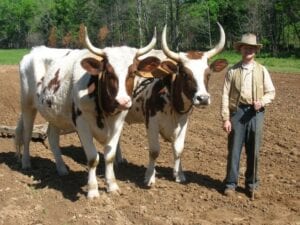 An ox is any castrated bull that is used as a work animal, but specific lines and breeds of cattle are sometimes used to produce huge, docile animals of burden.
An ox is any castrated bull that is used as a work animal, but specific lines and breeds of cattle are sometimes used to produce huge, docile animals of burden.
Slower and steadier than horses, they are much stronger, and better suited to pulling large cumbersome loads.
Oxen are primarily used to transport loads, plough land, and haul huge logs out of forests, but they can (and are) also ridden for transportation thanks to their calm temperament.
Goats
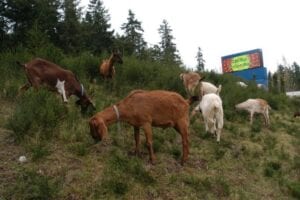
Goats were historically used to nurse infants directly (nanny goats) and were also used in slaughterhouses to herd and keep the other animals calm. Goats are known for their calming attribute when it comes to other animals. A spooky or nervous horse will often be stabled with a goat to keep him calm and provide him with company.
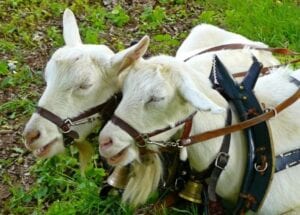 Goats are used for clearing scrub land and jungles, as their amazing ability to eat practically anything makes them highly effective land clearers. But they do this to a fault… if you leave them too long they will kill all trees in an area, which you typically don’t want. If you let them too near the house, they’re liable to eat things you don’t want eaten (and that you wouldn’t have thought could be). While they can be useful, they can also be a danger to personal property.
Goats are used for clearing scrub land and jungles, as their amazing ability to eat practically anything makes them highly effective land clearers. But they do this to a fault… if you leave them too long they will kill all trees in an area, which you typically don’t want. If you let them too near the house, they’re liable to eat things you don’t want eaten (and that you wouldn’t have thought could be). While they can be useful, they can also be a danger to personal property.
Goats can also be trained to pull carts on the small homestead that isn’t big enough to support a horse.
Others
 Elephants are used in the logging industry still today…
Elephants are used in the logging industry still today…
Cormorants are a marine bird that hunt fish. They are captured and used by fishermen in Asia…
Falconry: the original sport of kings. Falcons and other birds of prey have been trained for millennia to hunt for food and to kill pests like rodents…
While it takes time and patience to raise a bird from infancy (and you will probably need a license to do so) it is a majestic pastime for those with the patience.
